zeroair
Newly Enlightened
- Joined
- Aug 6, 2016
- Messages
- 130
[h=1]TNC Micro-Lux Dragon Flashlight Review[/h] TNC makes some very pretty lights and I have been eyeing a specific one for a long time. This TNC Micro-Lux Dragon is a 10440 twisty, but it's got a bigger head and a reflector – so it's not a typical keychain version of a 10440 light. Read on for some thoughts and testing!
TNC makes some very pretty lights and I have been eyeing a specific one for a long time. This TNC Micro-Lux Dragon is a 10440 twisty, but it's got a bigger head and a reflector – so it's not a typical keychain version of a 10440 light. Read on for some thoughts and testing!
[h=3]Official Specs and Features[/h]Here's a link to the official product page.
[h=3]Versions[/h]There are a bunch of body metal options of the Micro-Lux Dragon. Here's a search result where you can see all the options (which include more than just bodies, but also pocket clips and keyring connectors).
Here's at least most of these models:
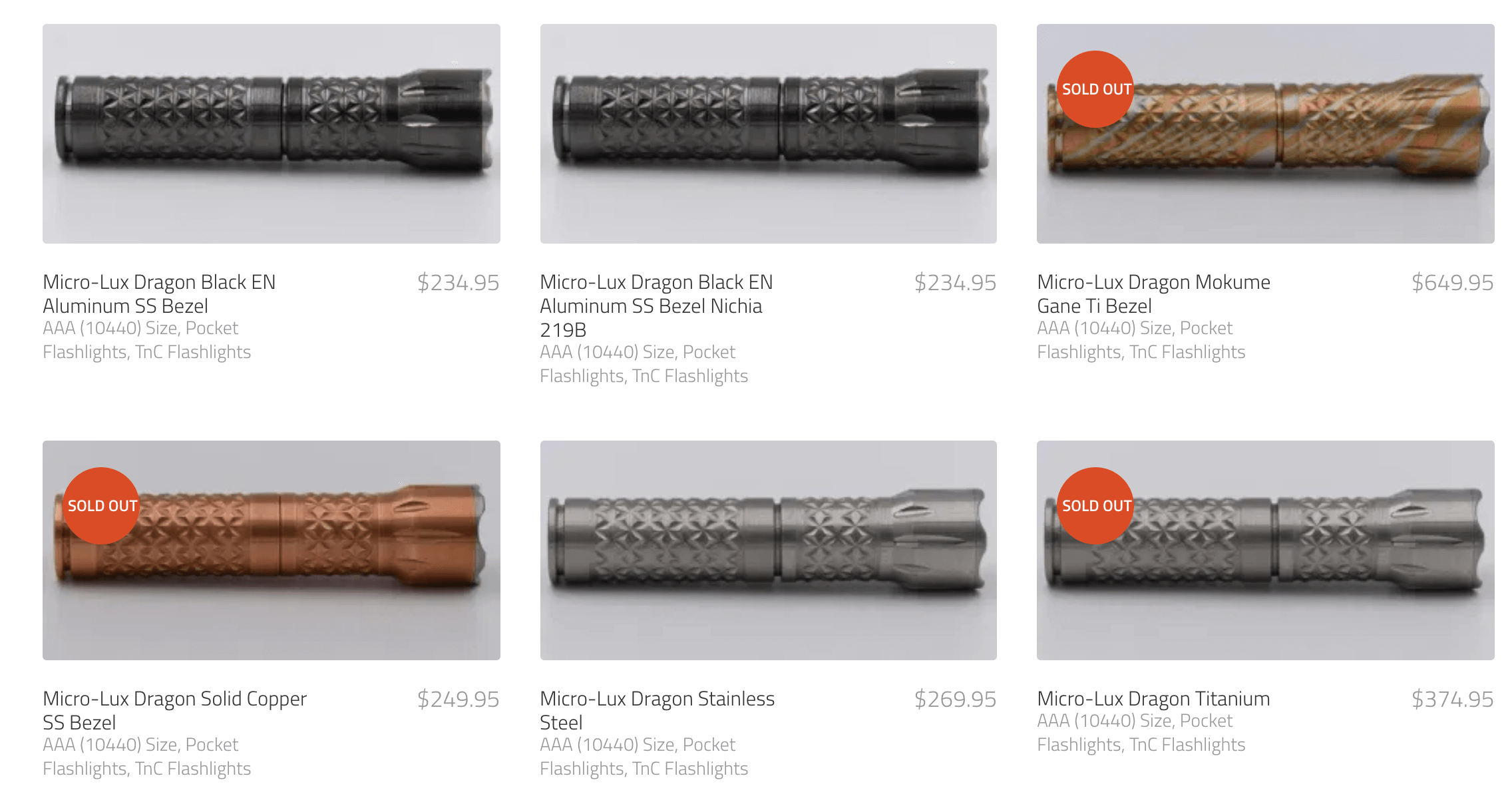
The option I have it the top left from the photo above.
[h=3]Price[/h]These go for $234.95 and are never seen at any sale price. The pocket clip is also an additional $20 and you can't not buy the pocket clip. I also included 2 Efest 10440 IMRs, which add another $12. Notably, the option I have here is the very least expensive option available.
[h=3]Short Review[/h]It's great to see high-end lights that aren't the standard 18350 triples…. As a "thrower" 10440, it finds itself in rarified air. The execution of this light is fantastic. There are a few things I'd like to see better in the design, though. But as far as "lookers" go this light is completely a winner.
[h=3]Long Review[/h][h=4]The Big Table[/h]


The light ships in the box seen above. There is no "product box" otherwise. The only product container is the velvet pouch.
There is no manual aside from the small piece of paper seen above. It does include a UI text.
[h=4]Build Quality and Disassembly[/h]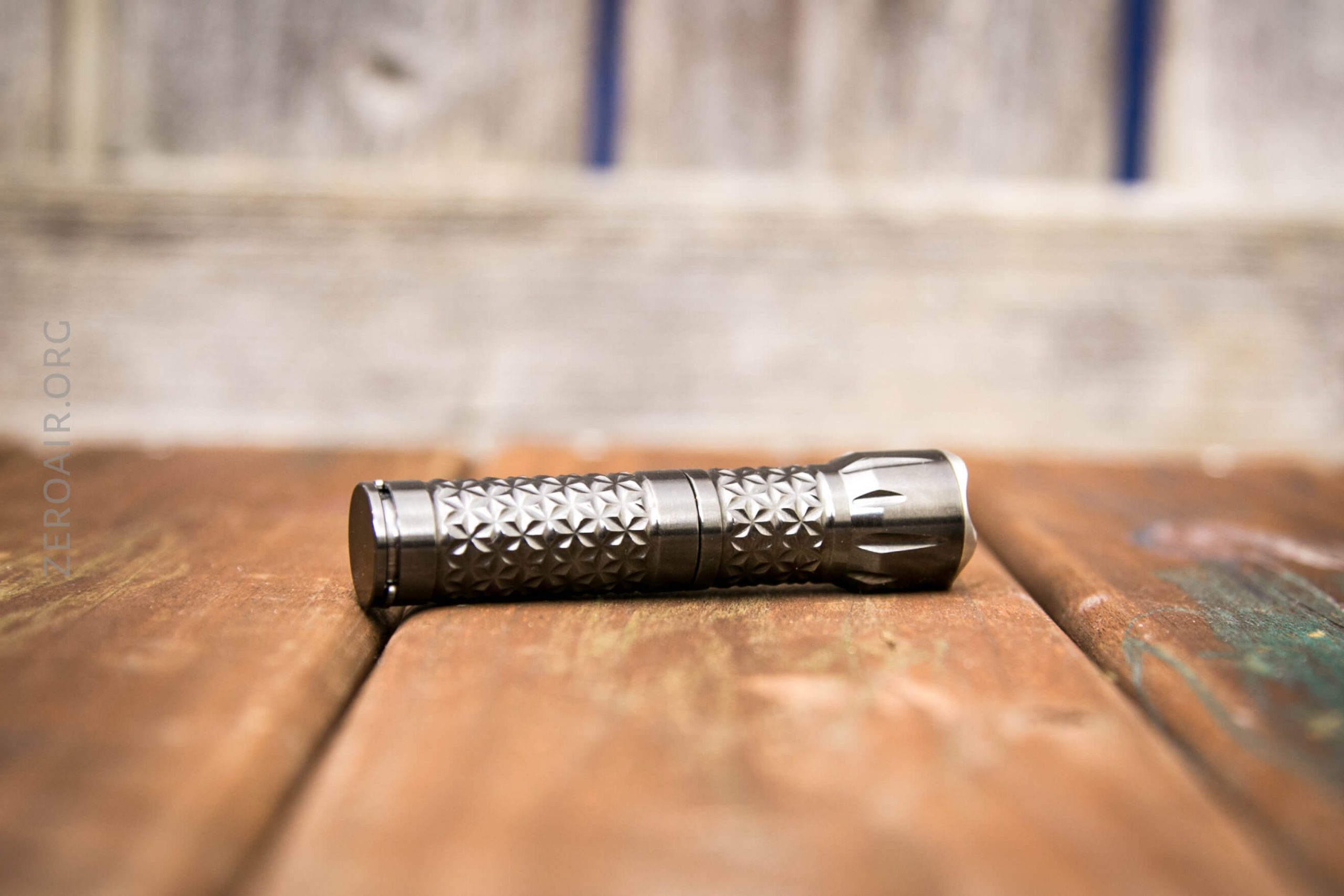
The build quality of this light is simply superb. The finish – the "EN" – means "Electroless Nickel" (despite that not being covered on the product page).
The EN finish is a simply fantastic. It gives the aluminum a glossy feel in hand, unlike any anodizing ever does. However it also still allows the aluminum to be seen through the finish. It's an unusual finish.




This light is also unusual in that the reflector is "big" for a 10440, giving the beam profile of a thrower. The centering of the emitter as can be seen below isn't an artifact of photography – the emitter is not perfectly centered.



The "Dragon" in the name of this light is due to the pyramid "knurling" pattern on the body. It's not quite as grippy as typical knurled lights, but it's grippy enough, and the threads are smooth enough, that the action is easy.





The head has a bit of fluting, which further facilitates the twisting action.

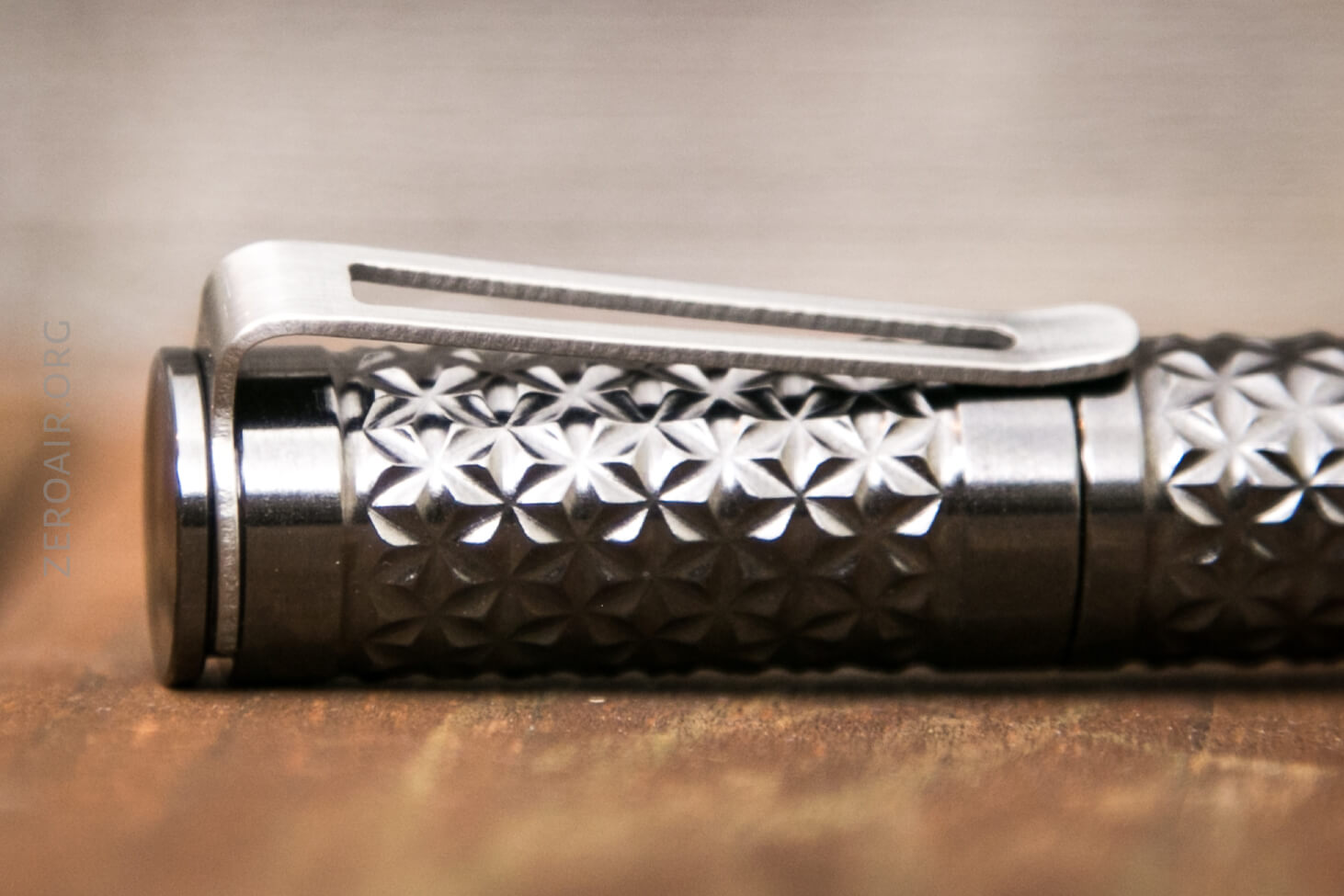
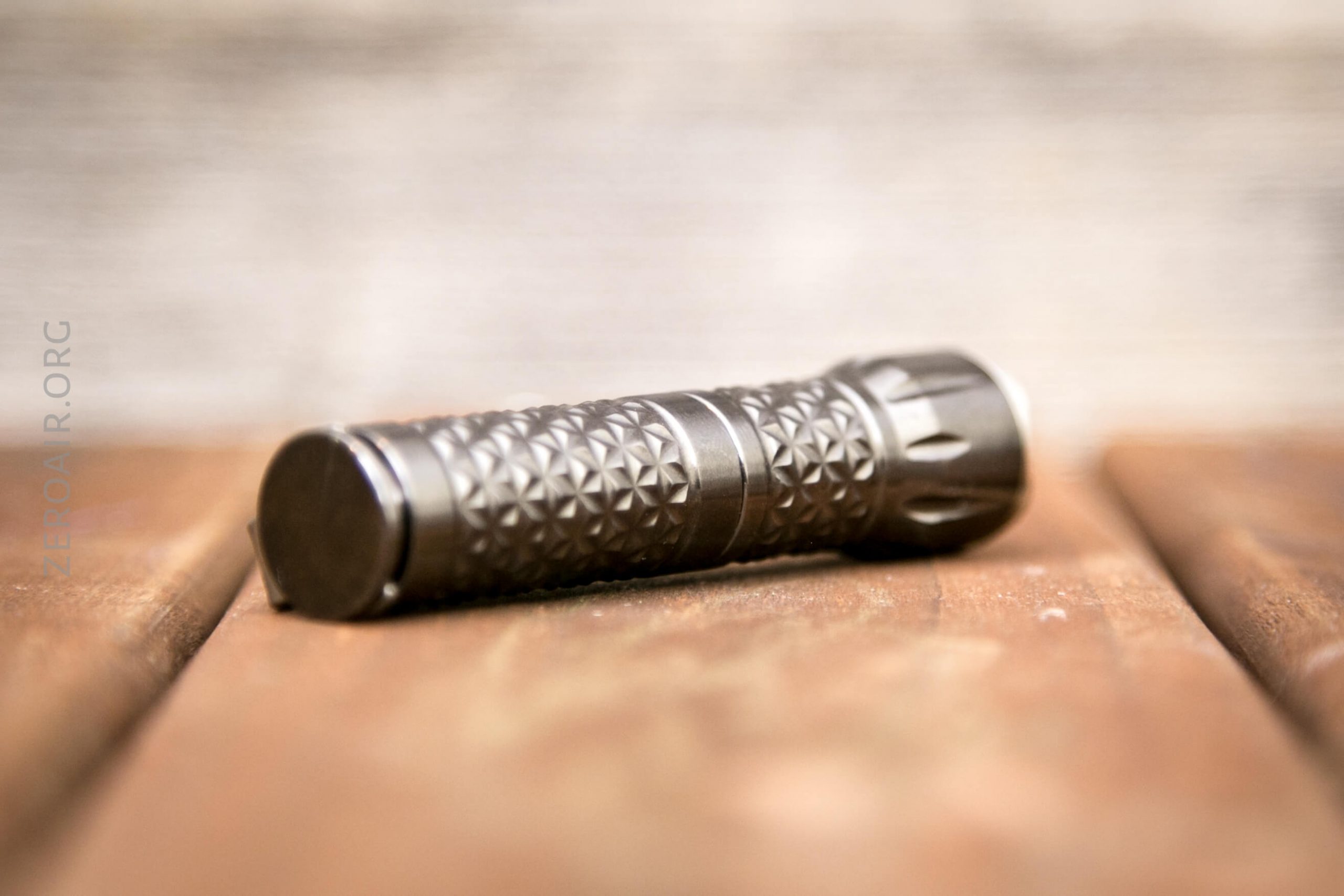
The tail end has only a button for negative contact on the cell. The head has a small spring. The driver is held in by a retaining ring, and so modification would be simple. The driver size is small though, so you're limited to only a few driver options. Mtnelectronics.com has at least one, and CWF makes the Chimera which can be made to fit in the light. The driver size is 10.7mm.

These threads are extremely smooth. They need to be, since this is a twisty.

One thing that you'll note about this light is that the head is much longer than twisties often are. One thing I discussed with the maker is surprise that there's no "short" body for this light – especially since TNC makes many other size lights, many of them very much smaller than this (already small) 10440. For example, TNC makes many N Cell lights, and I think (despite N Cell being 12mm in diameter), would fit in this light with a shorty body. It'd be a neat option! But there's nothing wrong that TNC doesn't do this. (It'd just be very, very cool!) (The point of this being that if you don't do this, why not just make a longer body and shorter head, as "normal.")
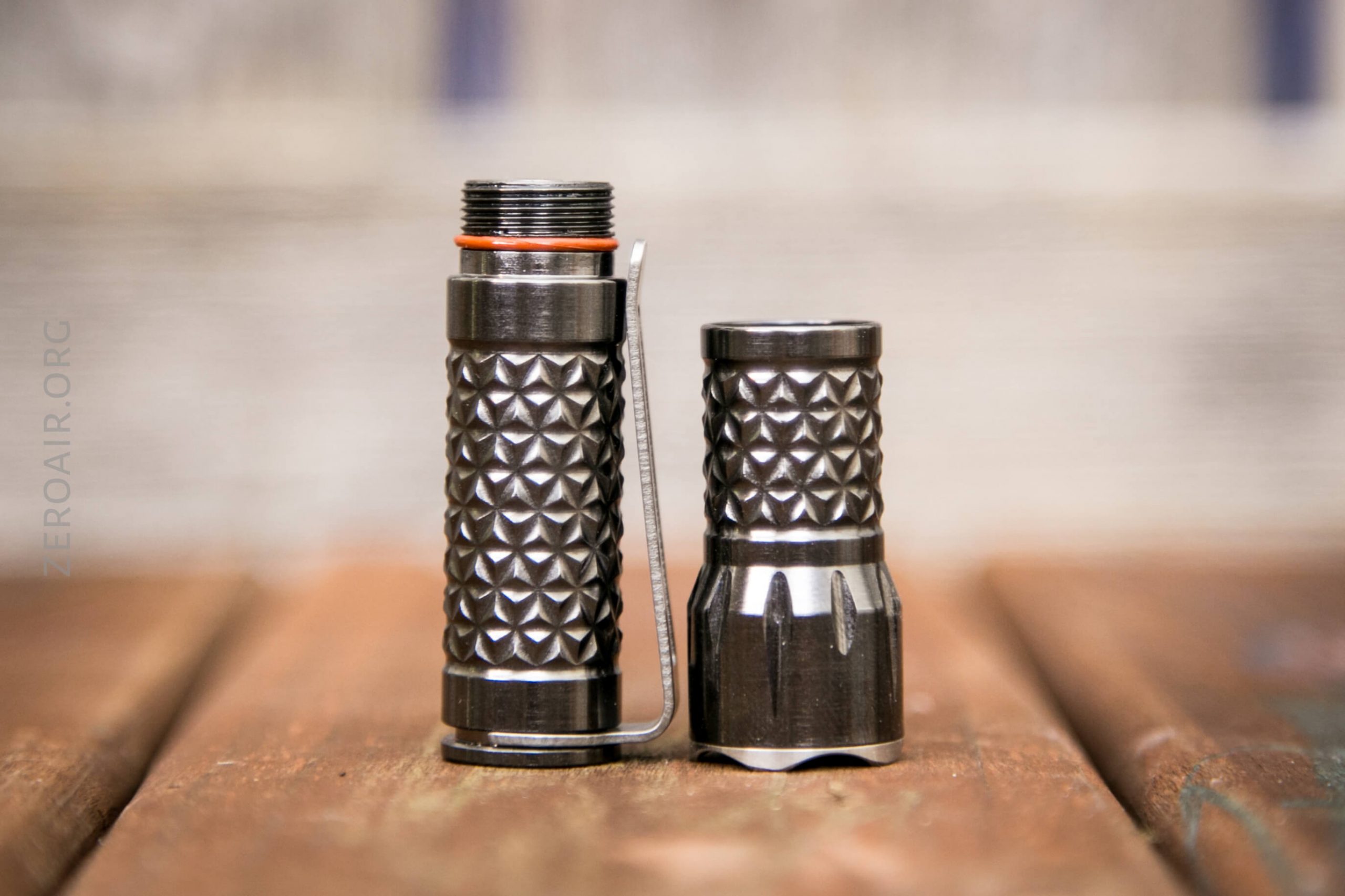
Here's one of my two problems with this light. The cell seen below is the 10440 cell that's available from TNC (as an additional purchase). There's a TON of room in that cell tube…. the cell practically swims in there. Extra room isn't necessarily a problem, but the cell rattles in there. The rattle is annoying, and adds a cheap feel to this ~$250 light. The last thing you want in a $250 light is for it to feel cheap…
Note the size of that tube further supports my idea that a N Cell shorty body would be fun.


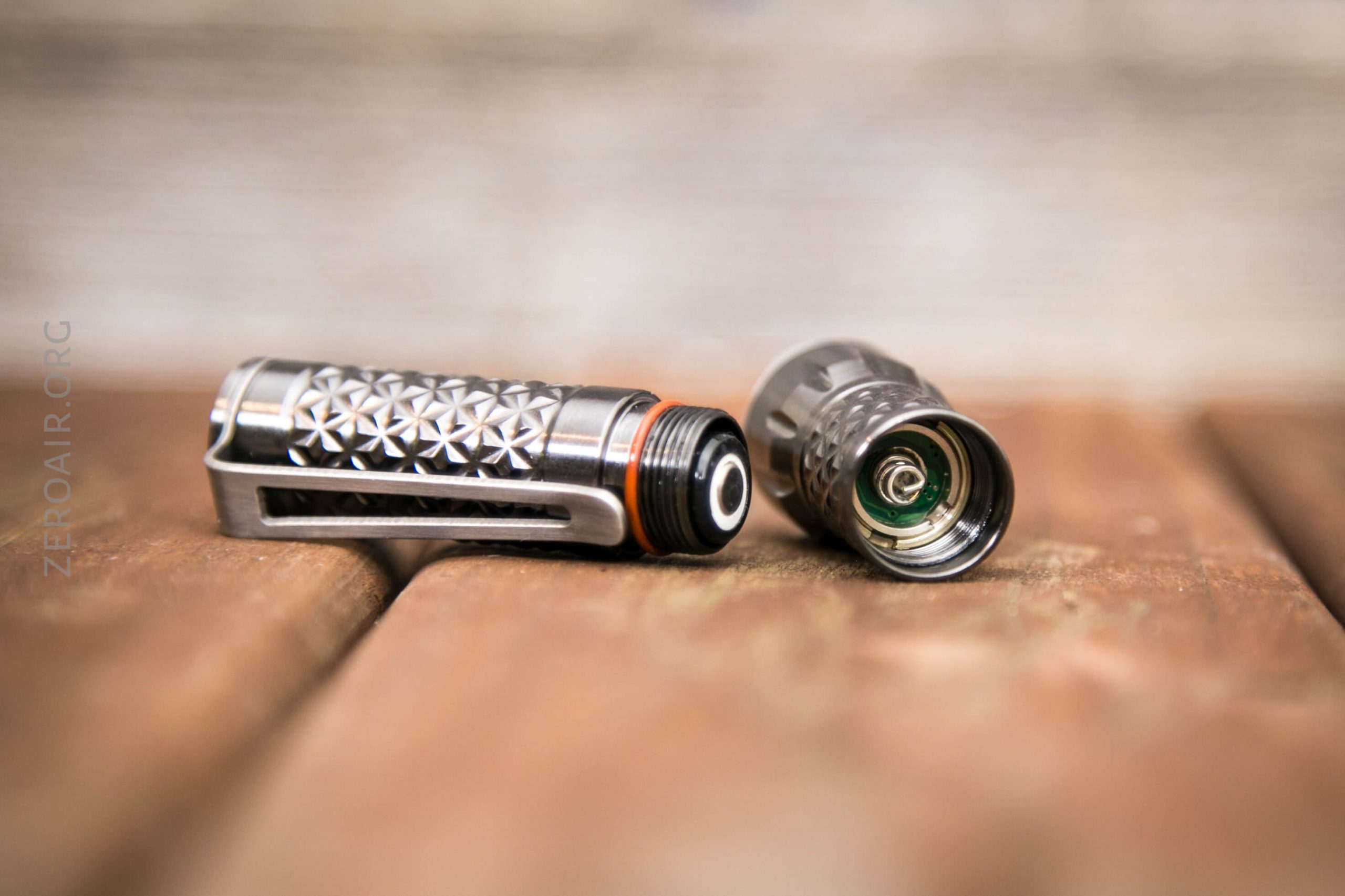
Below, the light is just in the off position. Twisted any tighter, and the light is on.

The bezel very nice and thin.


[h=4]Size and Comps[/h]From the maker:












[h=4]Retention and Carry[/h]Aside from the velvet pouch that you'll likely never use to carry the light, there are two options for carry of the TNC Micro-Lux Dragon. Both are accessory purchases. I purchased only the "half-moon" pocket clip, which friction clips around a specific groove in the tailcap area. The clip is technically reversible – it'll clip into the mid part of the body where the twist action happens. It'll fit there and the light will still operate properly. (This could be a design feature which explains the unusual proportions between the head and tail.) This "mid" clip position also means the light can be used as a hatlight.
The clip is very good. It is more than just a "half moon" though, because it's not really a friction fit clip. It uses tension on the tips of the two arms to squeeze, and not the whole arm to squeeze. It's a fine distinction, but it's still different.


The other option also fits in this groove on the taicap, and allows attachment to a keyring. It can't be used at the same time as the pocket clip.
A hole in the shoulder of the pocket clip would mean you could do both things with just the pocket clip. But there is no hole in the shoulder. The pocket clip does have a groove, which could also be used in this way.
[h=4]Power and Runtime[/h]The TNC Micro-Lux Dragon runs only on lithium ion cells. Lower voltage cells such as 1.5V primary/NiMH/etc cells are not supported. I find this to be greatly disappointing.
The cell used here is a 10440 cell. I purchased my cells directly from TNC, and they come in pairs. What you see below is the cell shipped from TNC just about swimming inside the cell tube. There's so much room in there that the cell rattles if the tube isn't tightened down most of the way. And if the tube is tightened down, the light is on. So either leave the light on, or have a rattling cell.

This is a massive disappointment about this light (and again, one of my "two problems" mentioned above). The execution of the design is fantastic (to wit: the build quality is next-level.) But the design that planned for this cell tube to be so broad in diameter is a big failing. Essentially this light should be taken back to the design stage, and shrunk down by about 1.5mm (more or less; I haven't measured yet).
Below are a couple of runtimes. The output specification claims around 700 lumens. I measure much less, and while you may fault the light for that, I do not. I don't aim for high output out of a small 219b light like this, so I'm satisfied here. Anyway, the output on the highest mode is FET output, so it could be the cell that's dragging the output down.
I did turn the light off in the test below, because the body heated up to the fringes of my comfort zone – around sixty degrees Celsius…. In hand that'd be too hot. This was "cooled" too so… Really the light needs a throttle I think, which is something I don't often ask for. There's really not enough mass in the head to handle a FET mode like this.

Output on medium is relatively stable, but runtime is short, at around 35 minutes. Around 80 lumens for 35 minutes is not extreme longevity.

[h=4]Modes and Currents[/h]
[h=4]PWM[/h]I have stated twice what my first problem with this light is. Here's my other. The PWM on the lower two modes is comically bad. It's so bad that my normal timescale doesn't pick up a full peak to peak pass. It's on par with the worst PWM I have, my "bad baseline." It's truly bad. High doesn't have PWM of course, because it's FET output.



Here are the same 3 modes, with a timescale that shows full peak to peak.


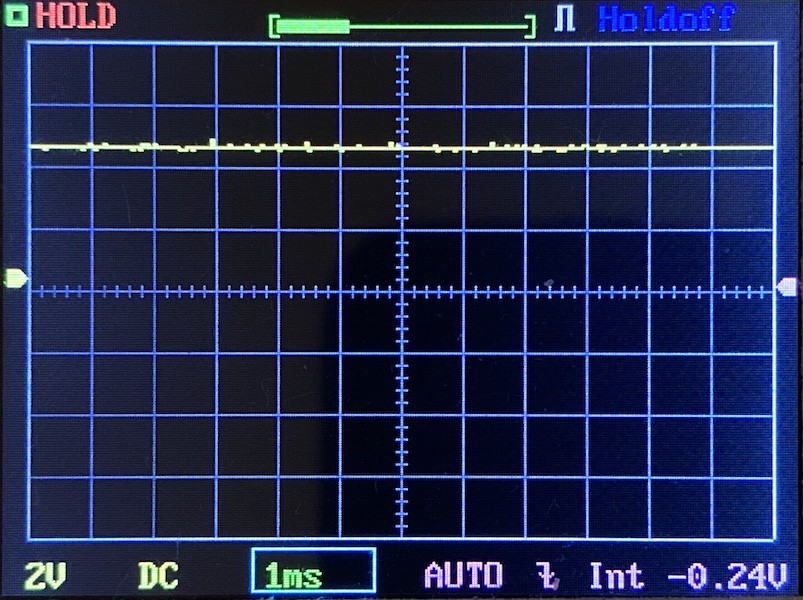
The PWM is so bad I immediately started thinking about swapping the driver. But with what? There are only two I know of (which I have mentioned above) and one of those is unavailable. The other (Chimera) is probably a fine driver, but would have to be sanded down (significantly) to fit into this light. It would probably be best to just see if some off-the-shelf light (like the Lumintop Tool AAA) has a driver that will fit in here. (The Tool AAA might not be driven as hard as you like, though.)
For reference, here's a baseline shot, with all the room lights off and almost nothing hitting the sensor. And here's the worst PWM light I have ever owned. Also one of the very first lights I ordered directly from China!
[h=4]User Interface and Operation[/h]The Micro-Lux Dragon is a twisty. Below the light is fully tightened (without a cell in place). There's plenty of real estate on the head for grabbing and twisting, and one handed operation is not too difficult.

The driver is a very simple 3-Mode Low Medium High. Twist for Low. Twist off and on (quickly) for medium. Twist off and on again (quickly) for High. The light has mode memory, too
[h=3]LED and Beam[/h]One of the very compelling things about this light is that it's still stocked with the Nichia 219b. The temperature is a very pleasing 4000K.
The emitter isn't perfectly centered in the reflector, but that doesn't seem to affect beam quality. The reflector is lightly orange peeled, and quite deep for such a small light.

Another downside of the light (which actually brings me to point number 3 of downsides…) is the beam shape. This is one of the ringiest beams I can think of. If you don't sit around pointing the light at white walls, then this will very likely not be a problem, however. I personally don't care so much about it.
These beamshots are always with the following settings: f8, ISO100, 0.3s shutter, and manual 5000K exposure.



[h=4]Tint vs BLF-348 (KillzoneFlashlights.com 219b version) (affiliate link)[/h]Test light is on the left!


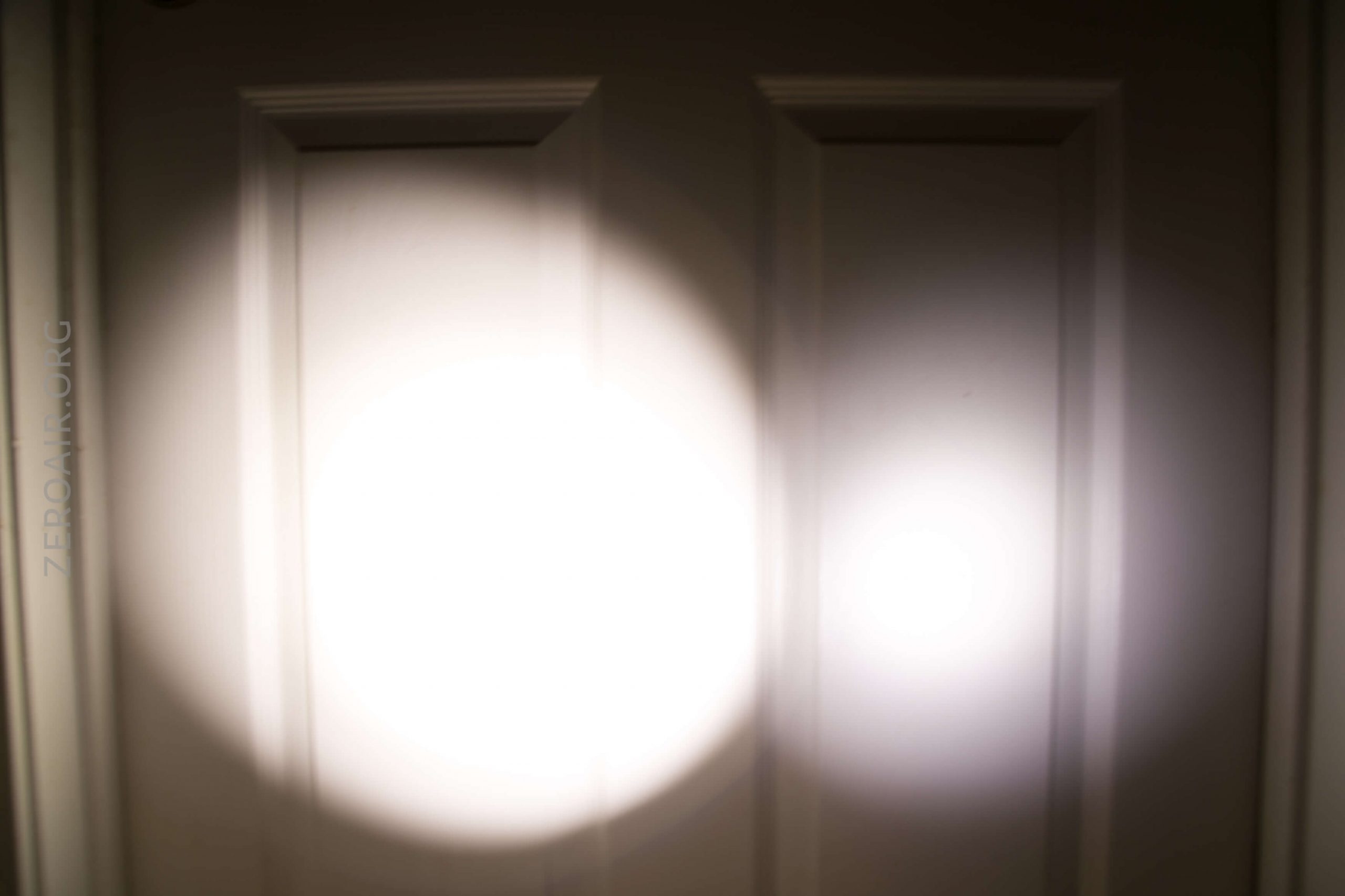
I compare everything to the KillzoneFlashlights.com 219b BLF-348, because it's inexpensive and has the best tint!
[h=3]Conclusion[/h][h=4]What I like[/h]
[h=3]Notes[/h]
I humbly submit this post for consideration in the review forum!
AUTHOR:TNC MICRO-LUX DRAGON FLASHLIGHT REVIEW
AUTHOR:TNC MICRO-LUX DRAGON FLASHLIGHT REVIEW
 TNC makes some very pretty lights and I have been eyeing a specific one for a long time. This TNC Micro-Lux Dragon is a 10440 twisty, but it's got a bigger head and a reflector – so it's not a typical keychain version of a 10440 light. Read on for some thoughts and testing!
TNC makes some very pretty lights and I have been eyeing a specific one for a long time. This TNC Micro-Lux Dragon is a 10440 twisty, but it's got a bigger head and a reflector – so it's not a typical keychain version of a 10440 light. Read on for some thoughts and testing![h=3]Official Specs and Features[/h]Here's a link to the official product page.
[h=3]Versions[/h]There are a bunch of body metal options of the Micro-Lux Dragon. Here's a search result where you can see all the options (which include more than just bodies, but also pocket clips and keyring connectors).
Here's at least most of these models:

The option I have it the top left from the photo above.
[h=3]Price[/h]These go for $234.95 and are never seen at any sale price. The pocket clip is also an additional $20 and you can't not buy the pocket clip. I also included 2 Efest 10440 IMRs, which add another $12. Notably, the option I have here is the very least expensive option available.
[h=3]Short Review[/h]It's great to see high-end lights that aren't the standard 18350 triples…. As a "thrower" 10440, it finds itself in rarified air. The execution of this light is fantastic. There are a few things I'd like to see better in the design, though. But as far as "lookers" go this light is completely a winner.
[h=3]Long Review[/h][h=4]The Big Table[/h]
| TNC Micro-Lux Dragon (EN Aluminum) | |
|---|---|
| Emitter: | Nichia 219b (4000K) |
| Price in USD at publication time: | $234.95 |
| Cell: | 1×10440 |
| High Runtime | Medium Runtime |
| LVP? | No |
| Switch Type: | Twisty |
| On-Board Charging? | No |
| Claimed Lumens (lm) | 700 |
| Measured Lumens (at 30s) | 285 (40.7% of claim)* |
| Candela per Lumen | 12.5 |
| Claimed Throw (m) | – |
| Candela (Calculated) in cd (at 30s) | 168lux @ 4.569m = 3507cd |
| Throw (Calculated) (m) | 118.4 |
| All my TNC reviews! |
- Measurement disclaimer: I am an amateur flashlight reviewer. I don't have $10,000 or even $1,000 worth of testing equipment. I test output and such in PVC tubes!! Please consider claims within 10% of what I measure to be perfectly reasonable (accurate, even).

- TNC Micro-Lux Dragon Flashlight
- Velvet carry pouch
- Paperwork
- [Extra purchase] Pocket clip
- [Extra purchase] Efest 10440 cells (pair)

The light ships in the box seen above. There is no "product box" otherwise. The only product container is the velvet pouch.
There is no manual aside from the small piece of paper seen above. It does include a UI text.
[h=4]Build Quality and Disassembly[/h]

The build quality of this light is simply superb. The finish – the "EN" – means "Electroless Nickel" (despite that not being covered on the product page).
Electroless nickel-phosphorus plating is a chemical process that deposits an even layer of nickel-phosphorus alloy on the surface of a solid substrate, like metal or plastic. Wikipedia
The EN finish is a simply fantastic. It gives the aluminum a glossy feel in hand, unlike any anodizing ever does. However it also still allows the aluminum to be seen through the finish. It's an unusual finish.




This light is also unusual in that the reflector is "big" for a 10440, giving the beam profile of a thrower. The centering of the emitter as can be seen below isn't an artifact of photography – the emitter is not perfectly centered.



The "Dragon" in the name of this light is due to the pyramid "knurling" pattern on the body. It's not quite as grippy as typical knurled lights, but it's grippy enough, and the threads are smooth enough, that the action is easy.





The head has a bit of fluting, which further facilitates the twisting action.



The tail end has only a button for negative contact on the cell. The head has a small spring. The driver is held in by a retaining ring, and so modification would be simple. The driver size is small though, so you're limited to only a few driver options. Mtnelectronics.com has at least one, and CWF makes the Chimera which can be made to fit in the light. The driver size is 10.7mm.

These threads are extremely smooth. They need to be, since this is a twisty.

One thing that you'll note about this light is that the head is much longer than twisties often are. One thing I discussed with the maker is surprise that there's no "short" body for this light – especially since TNC makes many other size lights, many of them very much smaller than this (already small) 10440. For example, TNC makes many N Cell lights, and I think (despite N Cell being 12mm in diameter), would fit in this light with a shorty body. It'd be a neat option! But there's nothing wrong that TNC doesn't do this. (It'd just be very, very cool!) (The point of this being that if you don't do this, why not just make a longer body and shorter head, as "normal.")

Here's one of my two problems with this light. The cell seen below is the 10440 cell that's available from TNC (as an additional purchase). There's a TON of room in that cell tube…. the cell practically swims in there. Extra room isn't necessarily a problem, but the cell rattles in there. The rattle is annoying, and adds a cheap feel to this ~$250 light. The last thing you want in a $250 light is for it to feel cheap…
Note the size of that tube further supports my idea that a N Cell shorty body would be fun.



Below, the light is just in the off position. Twisted any tighter, and the light is on.

The bezel very nice and thin.


[h=4]Size and Comps[/h]From the maker:
The flashlight has a length of about 3.1 inches and a head diameter of 0.73 inches, the body diameter is 0.615 inch.
The approximate weight with the battery is from 1.1 oz. to 2.1 oz.
The approximate weight with the battery is from 1.1 oz. to 2.1 oz.












[h=4]Retention and Carry[/h]Aside from the velvet pouch that you'll likely never use to carry the light, there are two options for carry of the TNC Micro-Lux Dragon. Both are accessory purchases. I purchased only the "half-moon" pocket clip, which friction clips around a specific groove in the tailcap area. The clip is technically reversible – it'll clip into the mid part of the body where the twist action happens. It'll fit there and the light will still operate properly. (This could be a design feature which explains the unusual proportions between the head and tail.) This "mid" clip position also means the light can be used as a hatlight.
The clip is very good. It is more than just a "half moon" though, because it's not really a friction fit clip. It uses tension on the tips of the two arms to squeeze, and not the whole arm to squeeze. It's a fine distinction, but it's still different.


The other option also fits in this groove on the taicap, and allows attachment to a keyring. It can't be used at the same time as the pocket clip.
A hole in the shoulder of the pocket clip would mean you could do both things with just the pocket clip. But there is no hole in the shoulder. The pocket clip does have a groove, which could also be used in this way.
[h=4]Power and Runtime[/h]The TNC Micro-Lux Dragon runs only on lithium ion cells. Lower voltage cells such as 1.5V primary/NiMH/etc cells are not supported. I find this to be greatly disappointing.
The cell used here is a 10440 cell. I purchased my cells directly from TNC, and they come in pairs. What you see below is the cell shipped from TNC just about swimming inside the cell tube. There's so much room in there that the cell rattles if the tube isn't tightened down most of the way. And if the tube is tightened down, the light is on. So either leave the light on, or have a rattling cell.

This is a massive disappointment about this light (and again, one of my "two problems" mentioned above). The execution of the design is fantastic (to wit: the build quality is next-level.) But the design that planned for this cell tube to be so broad in diameter is a big failing. Essentially this light should be taken back to the design stage, and shrunk down by about 1.5mm (more or less; I haven't measured yet).
Below are a couple of runtimes. The output specification claims around 700 lumens. I measure much less, and while you may fault the light for that, I do not. I don't aim for high output out of a small 219b light like this, so I'm satisfied here. Anyway, the output on the highest mode is FET output, so it could be the cell that's dragging the output down.
I did turn the light off in the test below, because the body heated up to the fringes of my comfort zone – around sixty degrees Celsius…. In hand that'd be too hot. This was "cooled" too so… Really the light needs a throttle I think, which is something I don't often ask for. There's really not enough mass in the head to handle a FET mode like this.

Output on medium is relatively stable, but runtime is short, at around 35 minutes. Around 80 lumens for 35 minutes is not extreme longevity.

[h=4]Modes and Currents[/h]
| Mode | Mode Claimed Output (lm) | Claimed Runtime | Measured Lumens | Tailcap Amps |
|---|---|---|---|---|
| High | – | – | 285 | [FET] (tested to 3A) |
| Medium | – | – | 87 | 0.45 |
| Low | – | – | 7 | 0.07 |



Here are the same 3 modes, with a timescale that shows full peak to peak.



The PWM is so bad I immediately started thinking about swapping the driver. But with what? There are only two I know of (which I have mentioned above) and one of those is unavailable. The other (Chimera) is probably a fine driver, but would have to be sanded down (significantly) to fit into this light. It would probably be best to just see if some off-the-shelf light (like the Lumintop Tool AAA) has a driver that will fit in here. (The Tool AAA might not be driven as hard as you like, though.)
For reference, here's a baseline shot, with all the room lights off and almost nothing hitting the sensor. And here's the worst PWM light I have ever owned. Also one of the very first lights I ordered directly from China!
[h=4]User Interface and Operation[/h]The Micro-Lux Dragon is a twisty. Below the light is fully tightened (without a cell in place). There's plenty of real estate on the head for grabbing and twisting, and one handed operation is not too difficult.

The driver is a very simple 3-Mode Low Medium High. Twist for Low. Twist off and on (quickly) for medium. Twist off and on again (quickly) for High. The light has mode memory, too
[h=3]LED and Beam[/h]One of the very compelling things about this light is that it's still stocked with the Nichia 219b. The temperature is a very pleasing 4000K.
The emitter isn't perfectly centered in the reflector, but that doesn't seem to affect beam quality. The reflector is lightly orange peeled, and quite deep for such a small light.

Another downside of the light (which actually brings me to point number 3 of downsides…) is the beam shape. This is one of the ringiest beams I can think of. If you don't sit around pointing the light at white walls, then this will very likely not be a problem, however. I personally don't care so much about it.
These beamshots are always with the following settings: f8, ISO100, 0.3s shutter, and manual 5000K exposure.



[h=4]Tint vs BLF-348 (KillzoneFlashlights.com 219b version) (affiliate link)[/h]Test light is on the left!



I compare everything to the KillzoneFlashlights.com 219b BLF-348, because it's inexpensive and has the best tint!
[h=3]Conclusion[/h][h=4]What I like[/h]
- Excellent execution of the design
- It's an absolutely gorgeous light
- I appreciate that this is a light that fits a niche not usually touched on by custom makers
- Twisty action is very smooth
- Uses Nichia 219b 4000K as the stock (only) emitter
- The design has way too much room in the cell tube – the cell rattles notably
- PWM from the driver is astoundingly bad
- Mode memory
- Gets too hot on High (aka unregulated FET)
- Ringy beam
- The cost is very high
[h=3]Notes[/h]
- This light was provided by me for my own personal enjoyment. I was not paid to write this review.
- This content originally appeared at zeroair.org. Please visit there for the best experience!

